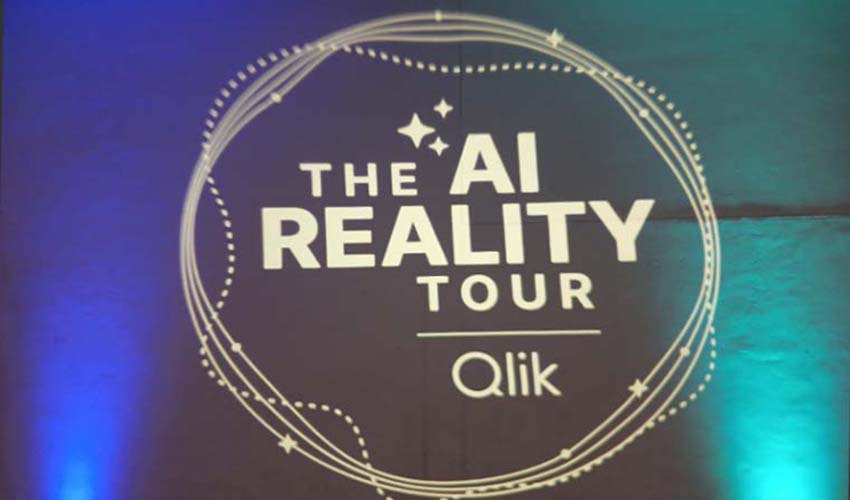Kathy Gibson reports from Qlik AI Reality Tour – There is no question AI is critical and companies that hesitate to harness it risk falling behind.
“But the question is: what are you going to do with AI?” asks Tejas Mehta, senior vice-president and GM: MEA at Qlik.
“It turns out you have to do the hard work, you cannot just skip to the end,” he adds. “And the success of AI starts with the data foundation.”
The reality is that ‘garbage in, garbage out’ still holds true – and with AI the garbage out can come with devastating speed and effect.
“Data quality will make or break your AI,” says Mehta. “Companies make important decisions based on data all the time. Bad outcomes because of poor data quality can damage the business.”
Qlik studies show that 72% of organisations say data limits their ability to take advantage of AI.
“Never has it been so important to get the data right,” Mehta says.
But building a solid foundation is not an easy task. “At Qlik we have been getting ready for this for years, and have built an analytics and AI foundation,” Mehta says.
“But we know it has to be flexible, to reach the customer where their data is. Which is why we do business where you do business – not the other way around.”
The trick is to take data and turn it into the desired outcomes, Mehta explains.
Qlik has come up with a framework for accelerated AI adoption that includes five key elements.
The first piece is about moving and transforming the data from any source; moving it at speed and with scale – and doing it in an automated fashion.
The second piece is around trust. You need to trust the data – where it is from, who has access and all the governance around data. This is critical to ensure confidence.
The third is about access, ensuring access for the correct people in a managed and structured way.
The fourth piece is a comprehensive approach to analytics to enable users to analyse, predict and answer.
The final piece is action, with automated outcomes as the goal.
“This is easy to understand, but hard to do,” Mehta warns.
Earlier this year, the company launched the Qlik Talend Cloud, a trusted foundation for AI, analytics and operation.
In most organisations, 80% of data is unstructured, so its important that users can trust the data they use to get answers.
Qlik Answers gives customers GenAI-driven answers from unstructured content with full explainability, Mehta explains.
The Qlik platform supports a broad community of users within customer organisations, says James Fisher, chief strategy officer of Qlik.
The Qlik Talend Cloud provides a data fabric for real time integration and quality at scale. This allows customer to maximise the transformative value of their data.
“We recognise that data is all over the ecosystem, so we need to ensure you can work with all the data, wherever it resides,” says Fisher. “You must be able to get it, regardless of where it comes from, into the right place, at the right time and in the right format.
“It has to be there in as near to realtime as possible. You want a full range of development options. And it must be trusted, run at scale, and run anywhere.”
In essence, Qlik offers a trusted data foundation for AI, with AI-ready data pipelines and a trust score for AI.
Bridging the gap between the data engineer and the data consumer is an increasingly complex problem, particularly as AI takes off and ecosystems become more complex.
“We have to break down silos, and ensure that key data is effectively shared,” Fisher explains.
There is real value in creating new models, leveraging the expertise of data owners to create data products that can be shared, are highly secure, versioned and controlled. These offer greater value for the organisations, Fisher explains.
Once a data model is verified, it can be made public in a company marketplace, and thereafter used by other users.
Once the data foundation has been established, customers need to turn data into an insight that drives action.
Qlik focuses on enabling analytics, self-service analytics and self-service AI.
“We help everyone in the organsation to achieve better outcomes by revealing answers that visualisation tools simply miss,” according to Fisher.
The first element is for the developer, offering a creation experience with improved navigation, better layout and visualisation, and AI-infused development to improve productivity with and for AI.
Predictive AI is possible because of automated modelling for time consuming tasks. Model recommendation protects users from selecting a bad model; while embedded insights allows for one-click insights on the model.
For instance Dataflow will soon be available, allowing developers and business users to quickly and easily transform data.
The end results is a analytics consumer experience that integrates with business apps, offers predictive AI for forward-looking questions, and includes GenAI that integrates with thousands of LLMs.
“The users in our organisations have very different expectations today,” says Fisher. “We have added features to empower users to get insights quickly.”
A new feature in Qlik is Insight Adviser which lets users simply address questions to the AI assistant Claude to get insights on future predictions.
Customers have indicated that unstructured data simply doesn’t allow them to get true value.
To address this, Qlik Answers helps users to create accurate responses based on actual data, including calls and emails. The data that underpins the responses can be checked and verified. Additional data sources not already in the repository can also be imported and queried.

